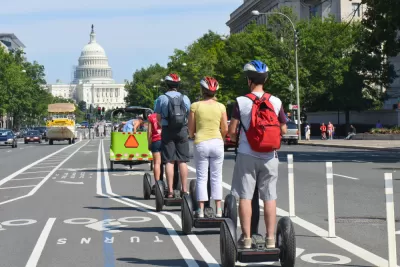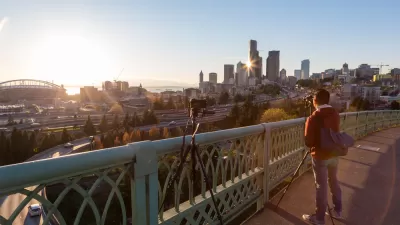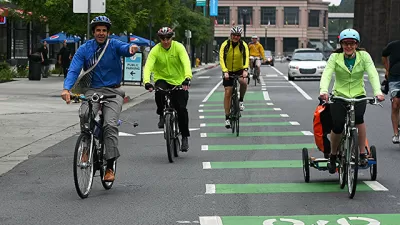The District Department of Transportation last week promised to double the pace of its planned construction of protected bike lanes, but advocates say the District still isn't doing enough to provide safe accommodations for people on bikes.

"The District is pledging to create an additional 20 miles of protected bike lanes in three years — a plan that would triple the number of miles of protected lanes citywide," reports Luz Lazo.
"The commitment replaces a more modest earlier goal to build 10 miles of protected lanes over a six-year period," adds Lazo.
Advocates for safe bike infrastructure say the city is still moving too slowly compared to other major U.S. cities: "New York City officials voted this fall to create 250 miles of protected lanes in the next decade, including 30 miles in the first year of implementation. San Francisco Mayor London Breed (D) in May announced that city would build 20 miles of new protected bike lanes in two years, doubling the pace of bike lane construction in the Bay Area."
The article includes more specifics and more skepticism from bike infrastructure advocates.
FULL STORY: D.C. vows to create 20 more miles of protected bike lanes by 2022

Study: Maui’s Plan to Convert Vacation Rentals to Long-Term Housing Could Cause Nearly $1 Billion Economic Loss
The plan would reduce visitor accommodation by 25,% resulting in 1,900 jobs lost.

North Texas Transit Leaders Tout Benefits of TOD for Growing Region
At a summit focused on transit-oriented development, policymakers discussed how North Texas’ expanded light rail system can serve as a tool for economic growth.

Why Should We Subsidize Public Transportation?
Many public transit agencies face financial stress due to rising costs, declining fare revenue, and declining subsidies. Transit advocates must provide a strong business case for increasing public transit funding.

How to Make US Trains Faster
Changes to boarding platforms and a switch to electric trains could improve U.S. passenger rail service without the added cost of high-speed rail.

Columbia’s Revitalized ‘Loop’ Is a Hub for Local Entrepreneurs
A focus on small businesses is helping a commercial corridor in Columbia, Missouri thrive.

Invasive Insect Threatens Minnesota’s Ash Forests
The Emerald Ash Borer is a rapidly spreading invasive pest threatening Minnesota’s ash trees, and homeowners are encouraged to plant diverse replacement species, avoid moving ash firewood, and monitor for signs of infestation.
Urban Design for Planners 1: Software Tools
This six-course series explores essential urban design concepts using open source software and equips planners with the tools they need to participate fully in the urban design process.
Planning for Universal Design
Learn the tools for implementing Universal Design in planning regulations.
City of Santa Clarita
Ascent Environmental
Institute for Housing and Urban Development Studies (IHS)
City of Grandview
Harvard GSD Executive Education
Toledo-Lucas County Plan Commissions
Salt Lake City
NYU Wagner Graduate School of Public Service




























